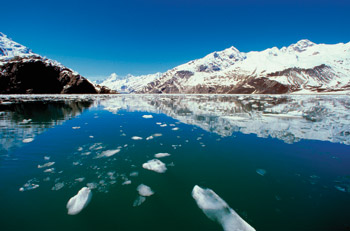Adding Fossil Fuel to the Fire
Mason climate experts find that global warming figures may be too conservative
By Tara Laskowski, MFA ’06
With the global warming debate heating up in the news, researchers at George Mason University and the independent Center for Ocean-Land-Atmosphere Studies (COLA) conducted a comprehensive, and somewhat controversial, study that showed global warming temperatures for the next century might be higher than have been estimated.
The study put current climate models to the test and for the first time ranked these complex systems in terms of accuracy. Results showed that when current models used to predict the Earth’s climate are ranked in this way, the more reliable models tend to project higher estimates of global warming for the next century.
A paper on the study, “Climate Model Fidelity and Projections of Climate Change,” which appeared in Geophysical Research Letters, presents a detailed mathematical analysis of the model simulations prepared for the Intergovernmental Panel on Climate Change (IPCC). It predicts that higher estimates of global warming—4 to 5 degrees Celsius as opposed to the model consensus range of 2 to 4 degrees Celsius—may be more likely.
This study is the first to relate the ranking of climate model accuracy to their simulations of future climate. In previous studies, the scientific community has been reluctant to evaluate models in relation to one another, but Mason and COLA scientists have used this comparison to stress an important trend in the current predictions of global warming.
 “Most reports of IPCC projections treat all models as equal, but we have found that some models do a better job of simulating the past century than others,” says Jagadish Shukla, professor of climate dynamics and the paper’s lead author. “Giving the higher fidelity models more weight implies a higher future global warming estimate than expected heretofore.”
“Most reports of IPCC projections treat all models as equal, but we have found that some models do a better job of simulating the past century than others,” says Jagadish Shukla, professor of climate dynamics and the paper’s lead author. “Giving the higher fidelity models more weight implies a higher future global warming estimate than expected heretofore.”
The researchers (Shukla, Timothy DelSole, Michael Fennessy, Jim Kinter, and Daniel Paolino) looked at the results of 14 current climate models from 10 different premier laboratories in five different countries. The identities of the models are being withheld to avoid promoting or criticizing individual models or modeling groups.
“It is somewhat controversial in the climate modeling community to rank the models, primarily because the climate system is complex, and an individual model may do well on one aspect of climate and poorly on others,” says Kinter, director of COLA, a research center in Calverton, Maryland, and an associate professor of climate dynamics at Mason. “It is also controversial from a political point of view, because the models are associated with particular institutions and their countries of origin, and no institution or country wants its model to be found to be inferior to other models.
“As a result, the usual IPCC practice of model analysis is to consider all models as equals. Our result, that the more accurate the model, the higher the estimate of future global warming, suggests that equal weighting among all models may lead to an underestimate.”
Changes predicted in the Earth’s climate for the next 100 years have scientists concerned, and Mason and COLA researchers hope their results will throw more light on the subject.
“This paper addresses one of the most important issues facing both the scientific community and the international policy community: namely, the magnitude of global warming because so much is at stake for the future of humankind and the planetary ecosystem,” says Shukla, who recently received the International Meteorological Organization Prize, which is considered the highest international award in the meteorological field, for his work.
If the Earth warms 4 or 5 degrees on average in the next century, that change could have a significant effect on certain geographic areas. “The sort of changes we are talking about are relatively small,” says Kinter, “but because the changes we have already seen in the past 100 years are unprecedented with respect to the past 400,000 years of the planet’s history, there is concern.”

